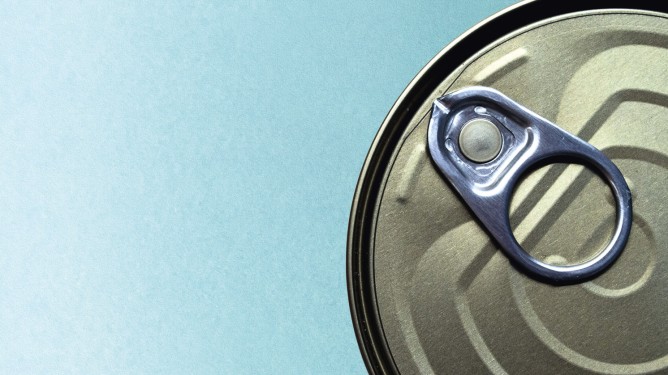New packaging steel service
Cans are now easy and convenient to open, thanks to the improved quality of steel. But it is still possible to produce new innovations even in the most established packaging materials such as those used in making food cans. This is something the Packaging Steel business in Andernach proves time and again. Its new material, rasselstein® Solidflex, makes it possible to use thinner materials that are just as sturdy as the old ones.
The material is also perfectly suitable for the small rivets that connect the tear-off ring to the lid. The rivet needs to be hard and solid to ensure that the connection to the lid does not give way. But the rivet also needs to be soft and flexible so that it can be easily pulled up off the lid. In short, it needs to be both solid and flexible, hence Solidflex.
Reduced thickness, reduced costs
Anyone who opens a can made of the new tin plate will immediately notice the difference. The greater hardness of the material also changes the way the lid opens, meaning even less force is required. “rasselstein® Solidflex is the latest product that demonstrates our continuous efforts to deliver real benefits to our customers,” says Dr. Peter Biele, CEO of the Packaging Steel business unit. “More efficient use of materials helps reduce costs and improve the customer’s competitiveness.”
The reduced thickness allows the customer to save money in many different ways. The customer uses less tin plate to make the same number of lids, which in turn reduces the carbon footprint of each package. On a similar note, the reduced weight makes it possible to transport a larger number of units at a time.
Various opportunities rasselstein® Solidflex will be used not only as a packaging material for food for humans as well as their pets. It will also be used to make the bottoms and domes of aerosol cans. The tin plate will soon be available for new product applications. Manufacturers who were previously using thicker materials could then opt for Solidflex, thanks to the remarkable properties it offers. A number of departments at thyssenkrupp Steel teamed up to develop the new material grade.
The hot-rolled steel that is used to produce the tin plate in Andernach is sourced from Duisburg. This is where the steel is manufactured to precisely defined specifications. “In collaborating on a technical front with the thyssenkrupp steel production team, we are able to draw on a wealth of collective experience,” says Dr. Helmut Oberhoffer, Head of Research at Packaging Steel. “This ensures that the starting materials have a very high degree of purity.”
This is what makes it possible to develop such a thin and sturdy material in the first place. Such synergies allow us to develop new products time and again. rasselstein® Solidflex may well be the next generation of tin plate, but it certainly won’t be the last.





